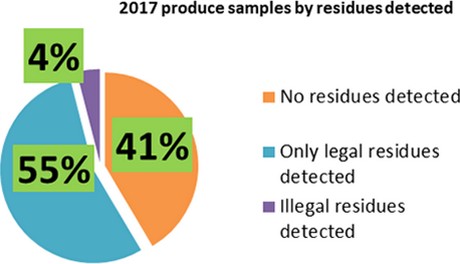The findings are included in DPR's just released 2017 Pesticide Residues in Fresh Produce report.
"DPR carries out extensive sampling of pesticides on fresh produce, and once again it shows that California consumers can be confident about eating fresh fruits and vegetables," said Brian Leahy, Director of DPR. "California growers and farmers are adept at following our comprehensive rules to ensure produce is grown to the highest pesticide standards."
The 2017 report is based on year-round collection of 3695 samples of produce, from 28 different countries, including those labeled as "organic." DPR scientists sampled produce from various grocery stores, farmers' markets, food distribution centers, and other outlets throughout California. The produce is tested for more than 400 types of pesticides using state of the art equipment operated by the California Department of Food and Agriculture.
The U.S. Environmental Protection Agency (U.S. EPA) sets levels for the maximum amounts of pesticide residue that can be present on fruits and vegetables, called a "tolerance." It is a violation if any residue exceeds the tolerance for the specific fruit or vegetable, or if a pesticide is detected for which no tolerance has been established.
California specific results
More than a third of the country's fruits and vegetables are grown in California according to the California Department of Food and Agriculture (CDFA). In 2017 DPR found:
About 25 percent of all produce samples tested were labeled as Californian-grown,
About 95 percent of these samples had no residues on them or were within the legal levels,
About 5 percent of California samples had illegal residues, including kale and snow peas. These are pesticide residues in excess of the established tolerance or had illegal traces of pesticides that were not approved for that commodity. However, none of those residues were at a level that would pose a health risk to consumers.
Other highlights from the 2017 report include:
41 percent of all produce samples had no detectable residues at all,
55 percent had residues detected within the legal level,
4 percent of all the samples had pesticide residues in excess of the established tolerance or had illegal traces of pesticides that were not approved for that commodity.

In 2017 produce that tested positive for illegal pesticide residues included Prickly Pear and Cactus Pads from Mexico which contained chlorpyrifos and monocrotophos; Longan Fruit from Vietnam which contained phenthoate, and Lychees from China which contained chlorpyrifos.
When illegal residues are found, DPR immediately works to remove the illegal produce to prevent it from reaching consumers and the department also attempts to trace it to its source. DPR then verifies that the produce is either destroyed or returned to its source.







